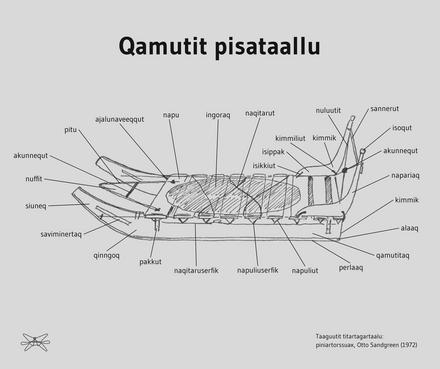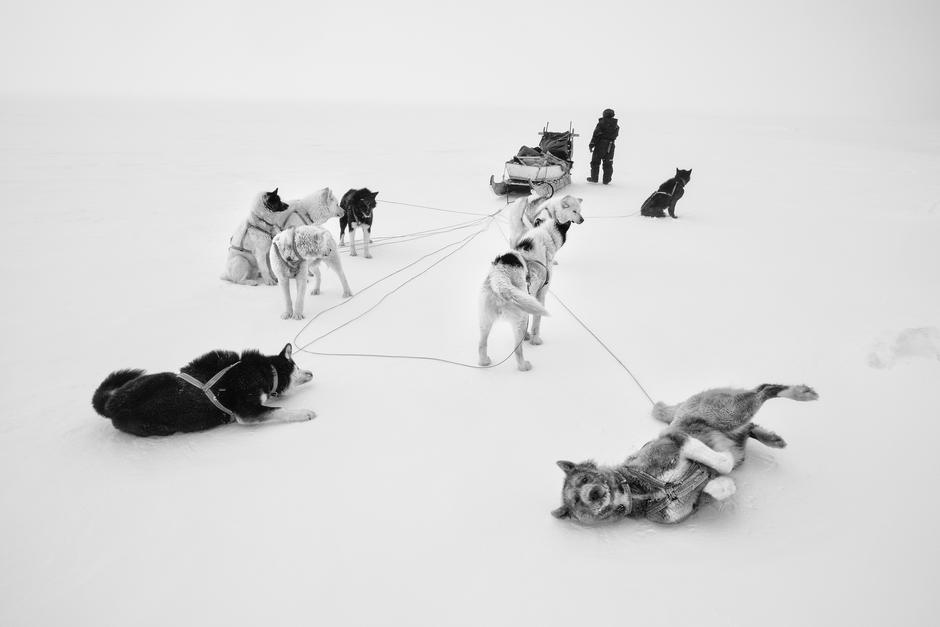
Terms in Greenlandic
Here, you can learn about the different parts of a dog sled and dog harness in Inuktitut/Greenlandic.
Culture
Sled dogs are more than just a mode of transportation in Greenland; they are deeply woven into people's lives, memories, and identity. This connection brings with it a wealth of experiences, stories, distinctive voices, and specific calls passed down through generations. Learning to drive a dog sled is not achieved by reading a book, but through hands-on practice, and the unique, profound relationship developed between human and dog in daily life.

The person in the picture is Johan Aaqqii. Ittoqqortoormiit, April.
Intangible Cultural Heritage
Intangible cultural heritage encompasses cultural practices, traditions, language, performances, crafts, and customs that lack a physical form but are vital to a group's identity and community. This includes movements, sounds, crafts, events, storytelling, and environmental knowledge. Therefore, sled dog culture demands physical and mental understanding, with practical skills requiring guidance from experienced individuals. This knowledge is embodied in physical actions, vocalizations, posture on the sled, and dog calls, transmitted through interactions with family members, neighbors, and, most critically, through the dogs themselves. Each sled dog possesses its own temperament and history, adding to this rich tapestry.
Today, sled dogs are widely recognized as a significant part of Greenland's cultural heritage. This heritage extends beyond the physical objects of sleds and dogs to encompass the unseen elements: the voices, stories, dog calls, and the profound feeling of commanding one's own dog team.

A female dog with her puppies. Saqqaq, July.
Oral Stories
Knowledge about sled dogs is often transmitted orally across generations or through personal relationships. This can occur during shared meals, hunting trips, or other daily interactions. Stories emerge spontaneously as someone shares a childhood memory, an experience from years ago out on the ice, or a tale of a remarkable dog. These stories are shared by recognized storytellers, experienced dog handlers, or anyone else, with no rigid rules governing the content beyond sharing lived experiences. Numerous books exist about sled dogs, with popular stories about sled dogs and journeys coming from notable figures such as Knud Rasmussen, Karl Siegstad, and Uno Fleischer.

Ilulissat, March 2018
Dog Sled Racing
Dog sled racing is a relatively recent cultural tradition among dog owners. Unofficial races began when a local people or colony manager initiated them as an competitive and entertaining event for the community. Inspired by this, local sled dog associations and organizations now host annual dog sled races. Before the official race, qualifying rounds are held in individual settlements, with local winners advancing to the grand final. Races are categorized for men, women, couples, and children, and variations exist in length, location, terrain, and weather conditions.
Notable races include:
- Inughuit Qimussersuat, Avanerriarmi Hukateerruunneq: A traditional race that began in 2018 in Northwest Greenland, spanning over 170 km and held in April with approximately 19 participating jockeys from Qaanaaq, Siorapaluk, Savissivik, and Qeqertat.
- Avannaata Qimussersua: A large, famous race staggered among different West Greenlandic residences. It was first organized in 1989 by Kalaallit Nunaanni Qimussertartut Kattuffiat (KNQK) in collaboration with local associations. This race garners significant attention and is covered by both the press and national TV.
- Kangiala Qamutsertua: A race held in the Tasiilaq area.
- Qamutseer 2016: A race that takes place in the Ittoqqortoormiit area.
- Avannaata Qimussersui: Held every three years, allowing coachmen from all regions (Avannaata Qimussersua, Kangiata Qimussersua, Inughuit Qimussersua, Upernaviup Qimussersua, Qeqqata Qimussersua North, West, and East) to participate. The next race is scheduled for Qeqertarsuaq in 2027.
Organizing these races demands substantial effort, and all events are volunteer based. Freight costs alone can exceed one million Danish kroner, in addition to dog food and accommodation for participants. Participants typically arrive about a week before the race, engaging in various cultural events leading up to the main day, including storytelling, socializing, and communal dining, with a strong focus on dogs and drivers. During famous dog sled races, shops often close to support the event, highlighting their community importance.
You can read more about the organization and the associations here.